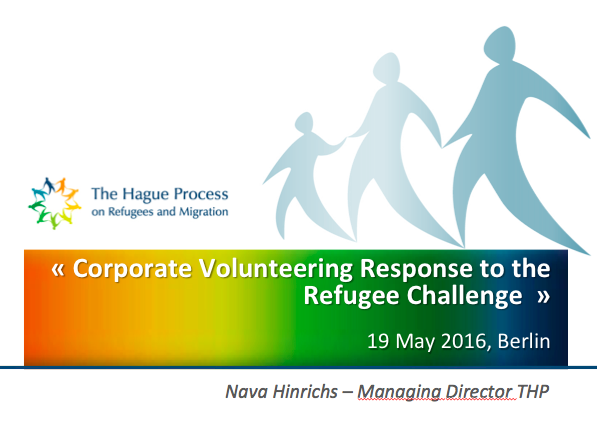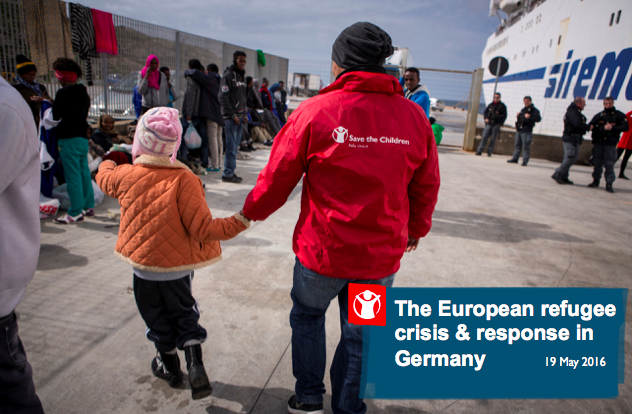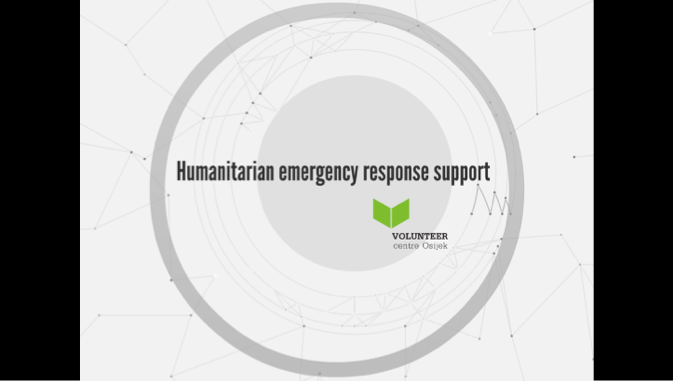
Purpose & Perspective | Agenda | Corporate Volunteering for Refugees | Key Findings & Themes |
Challenges & Conclusion | Presenters & Attendees | Resources & Media
Collaborations are enabling organizations to do more than they would otherwise alone. The German Wir Zusammen (We Together) campaign includes thirty-six major German companies joining forces to form an initiative to promote the integration of immigrants. It was launched by Ralph Dommermuth, founder and chairman of the German internet company United Internet AG. The TENT Alliance of the TENT Foundation, started by Chobani founder, CEO and former refugee, Hamdi Ulukaya, was announced earlier this year. Thirty percent of Chobani employees have been migrants or refugees, which has sensitized the company to the current plight of refugees and inspired Ulukaya to commit resources to help improve their situation. The TENT Alliance was created to amplify the work of companies around refugees by bringing companies, governments, refugee relief organizations and academia together. Federico Carlos Baradello, Advisor to the TENT Foundation, explained a pilot project they are working on with LinkedIn Sweden to leverage the network of LinkedIn to help refugees find jobs and to present themselves in best possible way in their LinkedIn profiles.
Through collaboration companies minimize duplication of effort, expertise and resources; save dollars; gain more impactful outcomes; and encourage knowledge sharing and creative, innovative solutions. NGOs while they work in an increasingly competitive funding environment would also benefit from collaboration and partnerships rather than resource sapping competition. In responding to the refugee crisis, it is useful to leverage the expertise of National Volunteer Centers and established migrant and multicultural associations. It is also critical to hear and learn from the refugees in order to understand potential barriers to assistance and cultural sensitivities.
[gdlr_divider type=”solid” size=”100%” ]
Nava Hinrichs, CEO, The Hague Process on Refugees and Migration presented recently completed research illustrating the costs and benefits of migration for business. In multi-country surveys 85% of respondents said that migration leads to a strong workforce. It was clear that for refugees and migrants work reduces potential challenges and importantly provides immediate immersion and integration in addition to a living. This makes corporate programs that lead to employment particularly valuable and the employee volunteer mentors that help smooth refugee adjustment to the work setting especially important.
While it does not appear that companies help refugees for branding purposes, there are benefits that accrue to companies with employee volunteers. In addition to pride in the company that works to benefit society, employees can learn valuable leadership lessons, can develop their professional expertise by applying it in new and different ways, and enhance soft skills such as listening and cultural sensitivity.
[gdlr_divider type=”solid” size=”100%” ]

[gdlr_button href=”https://www.iave.org/iavewp/wp-content/uploads/2016/06/Hague-Process-Forum-Presentation.pdf” target=”_blank” size=”medium” background=”#2b5b73″ color=”#ffffff”]View Presentation[/gdlr_button]
[gdlr_button href=”https://www.iave.org/iaveforum2016/presenter-bios/#nava” target=”_blank” size=”medium” background=”#2b5b73″ color=”#ffffff”]About the Presenter[/gdlr_button]
Children have special needs, as they are the most vulnerable refugees Jessica Sommer, Director, Corporate Partnerships and Foundations, Save the Children Germany, explained. Children on the move, especially those unaccompanied are at risk of exploitation, abuse, violence and trafficking as they journey from their point of origin to Western European countries. Children are impacted by PTSD, the potential for malnutrition, dehydration and a lack access to of child -friendly asylum procedures and information.
While corporate volunteers do not often work directly with children given these sensitivities, there is much that their support can accomplish that will benefit child refugees. Corporate employees have raised funds for specific Save The Children projects as the C&A Foundation did for mothers and children in crisis. Ikea employee volunteers designed and set -up child-friendly place spaces especially for the refugee camps with supplies donated by the company.
[gdlr_divider type=”solid” size=”100%” ]

[gdlr_button href=”https://www.iave.org/iavewp/wp-content/uploads/2016/06/Save-the-Children-Forum-Presentation.pdf” target=”_blank” size=”medium” background=”#2b5b73″ color=”#ffffff”]View Presentation[/gdlr_button]
[gdlr_button href=”https://www.iave.org/iaveforum2016/presenter-bios/#jessica” target=”_blank” size=”medium” background=”#2b5b73″ color=”#ffffff”]About the Presenter[/gdlr_button]
Many employee populations consist of individuals who were refugees themselves. Companies have reported that former refugees are among the first to offer help to current refugees often using their language skills and other means of assistance. Several companies report that current refugees are also quick to get involved in volunteer projects, much as Lejla Sehic Relic did in Croatia to build skills, provide a distraction, and pass the time. Vahida Hurzokovic, from Sloven Philanthropy, was also a refugee of the Bosnian War. Volunteering by refugees helps them see themselves as a resource instead of just a recipient of aid.

[gdlr_button href=”https://www.iave.org/iavewp/wp-content/uploads/2016/06/Croatia-Volunteer-Center-Forum-Presentation.pdf” target=”_blank” size=”medium” background=”#2b5b73″ color=”#ffffff”]View Presentation[/gdlr_button]
[gdlr_button href=”https://www.iave.org/iaveforum2016/presenter-bios/#lejla” target=”_blank” size=”medium” background=”#2b5b73″ color=”#ffffff”]About the Presenter[/gdlr_button]